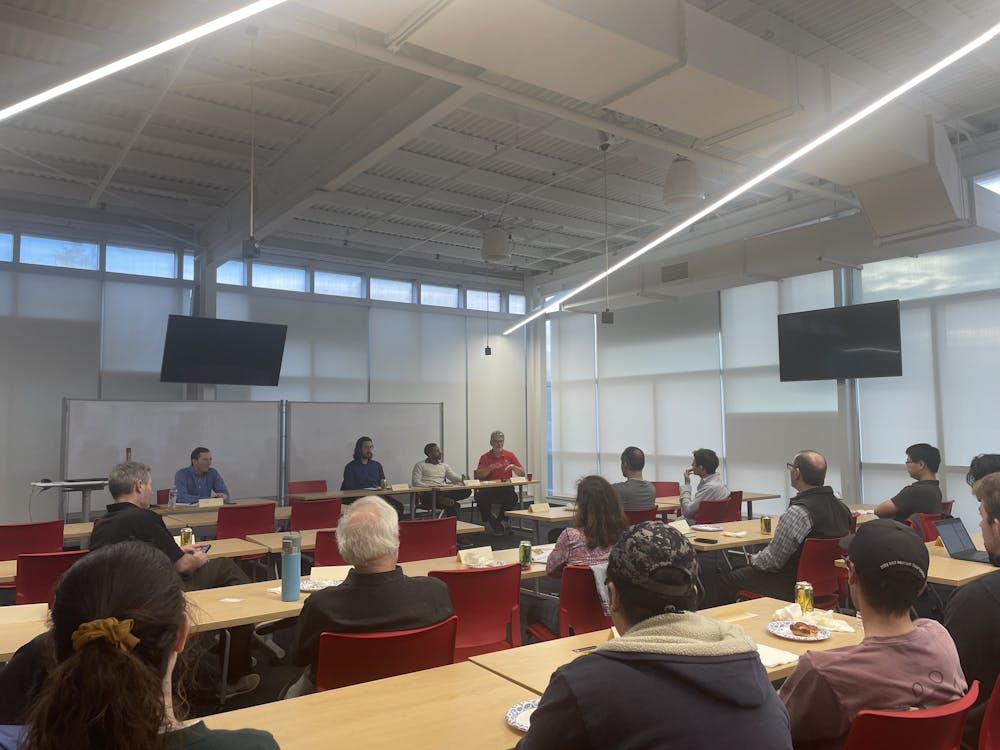When thousands of college students across the country graduate, the frustrating journey of trying to find their dream job begins. For some, an entry-level job is waiting for them after their time at college has ended. For about 40% of recent graduates, their full-time job is simply looking for a job.
RJ McWilson, an Otterbein accounting major who graduated in the class of 2023, knows the struggle of the job search all too well. His outgoing emails are filled with his applications, resumes and cover letters—many left unanswered without even as much as a rejection letter.
This job search has always been difficult, but the implementation of artificial intelligence, or AI, is making many people worry about the future of humans in the workforce.
McWilson is confident that AI is partly the culprit, by saying that in many cases, his applications are denied the same day.
Jobs in McWilson’s field, accounting, are increasingly at risk of being replaced by AI. A study by the Pew Research Center says that white collar jobs include the most exposure, or employment threats, to AI.
Along with these findings, the same study also shows that minority groups are also more likely to have jobs that are impacted by artificial intelligence. Among those most exposed to AI are women, Asian workers and individuals with a bachelor’s degree or higher.

How Otterbein is preparing students
Professors in some disciplines on Otterbein’s campus are changing their curriculum to prepare students for careers that are impacted by artificial intelligence.
For example in degree programs like marketing, data analysis, business and economics are using AI to help teach students about real world possibilities. Associate professor of business, accounting, and economics, Dr. Ava Liu uses AI in the classroom to push students to use technology as a tool instead of a crutch.
Liu assigns students to use AI to spark creativity about what some of the best ways to sell products would be.
“I asked students to compare what AI told you, what you have developed, what you have found using Google trends, using experiment tests in Google by testing several key words, what you're understanding as a group of young adults,” says Liu.
In fact, her class ranked in the top 25 participants of the Digital Marketing Competition and Summit, where more than 240 college teams from all over the world competed, incorporating artificial intelligence to make a video presentation and marketing report for Radio Flyer, an electronic bike company.
Other Otterbein faculty are continuing to focus on human creativity, critical thinking, and reasoning. These aspects have remained valuable, despite past big shifts in technology, such as computers and social media.
Otterbein art department Chair, Jonathon Johnson says critical thinking and creative decision making is still at the heart of what professors are teaching. His photography classes continue to center around how to use a camera and photo editing software, but also what design aspects make good photos and how to work with subjects to portray emotion through photography.
Johnson is getting outside the editing lab, opting more to take students to shoot pictures in the real world, spending less time with editing, due to the advancements of photo editing artificial intelligence.
Still, students are concerned about the future that AI will have for artists.
“I don’t think we’ve even ever had this conversation of how AI would affect an artist’s life,” says Fatima Bashar, a junior photography major at Otterbein University. She says, “That could change some artists, especially the digital market like photography or graphic design.”
Bashar has not worked with artificial intelligence in creative forums like Adobe, because she prefers the “rawness” of her photos.
“I think there is also a group of us that will recognize what’s AI and what’s not and value that over, but there’s also other people who might look the cheaper way out and it might be AI,” says Bashar.
Artificial Intelligence Failures
While artificial intelligence is continuing to make advances, it is still prone to making mistakes. In many cases, these mistakes stick out like a sore thumb for the company or organization when they are found out by the public.
The Columbus Dispatch can prove that humans are a necessary part, in at least, overseeing artificial intelligence. Their AI generated sports stories use terms like “close encounter of the athletic kind.” In part because of a media backlash, the local media organization has since ceased the use of an artificial intelligence writing tool.
Another example of why humans must still be in the driver's seat of innovation, is the recent blunder that artificial intelligence made for the obituary of NBA player, Brandon Hunter. Microsoft’s MSN news portal recently published an obituary generated by artificial intelligence, describing Hunter as, “useless.”
These stories being created with artificial intelligence come at a cost of credibility for these news organizations. Especially since these types of stories are usually given to entry-level journalists.
These AI flops have even reached the legal field. Recently, a New York judge sanctioned lawyers for citing fake court cases in their briefs written by artificial intelligence.
Still, the development of AI is a billion-dollar industry, with companies like Google and Amazon leading the way and opening their wallets.
Protecting workers
With the increasing developments of artificial intelligence, organizations like the ACLU are already pushing for regulation of AI and fighting for the rights of workers from unfair use of artificial intelligence in the hiring process and in the professional world.
“Many of these (artificial intelligence) tools pose an enormous danger of exacerbating existing discrimination in the workplace based on race, sex, disability, and other protected characteristics, despite marketing claims that they are objective and less discriminatory,” according to the ACLU website. The ACLU’s statement, released in August of last year, calls for legislation that enforces employers to notify hires when AI is being used, assess their impact on privacy and nondiscrimination with their uses of AI, and impose additional non-discrimination responsibilities on employers who are using AI in the hiring process.
For now, it appears that employees have the upper hand in labor in the United States. Data shows the number of jobs strongly outweighs the number of workers in the United States, with a difference between 10.5 million job openings, and only about 6.1 million people seeking work. This gives employees unprecedented power.
Only the Strategic Succeed
To get to the point where recent graduates are being interviewed by actual humans, in many cases, they must appeal to the artificial intelligence that is placed in charge of reading cover letters, scanning resumes, and even in some cases, completing a filmed interview to be processed by AI.
Paul Newell, Associate Director Student Success & Career Development at Otterbein University helps students work around the artificial intelligence that is used in the hiring process.
“Students need to realize that when they are applying for jobs and they're seeking employment that there's always a piece of computer, a piece of AI equipment that is basically starting the process of recruiting candidates,” says Newell. “They have to be really on top of that to make sure that their documents are accurate, that they have the right keywords, and all that is part of what is all included in the process for applying for jobs.”
The advice Newell gives to students is to always use the job description’s keywords in their resumes and cover letters and to start thinking about how they can get ahead of the curve in technology by familiarizing themselves with AI. He also says to be cautious of using AI in creating their actual documents for a job.
“It’s kind of a two-edged sword,” says Newell. “They're creating mechanical devices to detect if (hires) used an AI piece of equipment for their cover letters or their resume.” Companies want to see that candidates’ work is the actual work of the candidates, while they use artificial intelligence to scan through those documents.
As for RJ McWilson, his hard work navigating the artificial intelligence in the hiring process has paid off. Exactly 162 days after his graduation ceremony, he was awarded a job with Huntington Bank in an entry-level position.
He attributes his success to using the buzzer words on a job posting in his resume, and doing research on the company to show knowledge of the company in his cover letters.
“At least I was able to get a foot in the door,” says McWilson. “That’s what matters.”








